|


Editorial
|
Press Releases
|
Book Reviews
|
Fragments
Serpent Mound II
|
Giants II
|
Osiria II
Register
for our new Hall of Records Newsletter!
Questions? Comments? Suggestions? Advertising? Press Releases?
Contact us!
Atlantis in Bolivia
|
Alexandria
|
Pharos Lighthouse
|
Champ
|
Books
|
Video

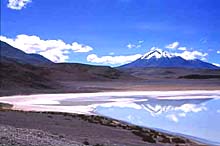
The Bolivian Altiplano, the highest plateau in the world. The Altiplano is a stark wilderness flanked by the Andes and abundant with volcanoes, geysers and hot springs, reminiscent of Plato's description of Atlantis:
"The whole region rose sheer out the sea to a great height but the part about the city was all smooth plain, enclosing it round about and being itself encircled by mountains that stretched as far as the sea".
— Plato,
Critias
|
|
For many the name Atlantis seems to imply that this fabled lost continent once lay in the Atlantic Ocean, as Plato's description, attained via the Greek lawgiver Solon from the Ancient Egyptian priests, described a continent lying opposite the Pillars of Hercules (Straits of Gibraltar). Thus explorers searched for answers in this region. Nobody for one minute suspected that it could even lie inland, let alone high up in the Andes mountains. Nobody that is, except one man: Jim Allen.
At an elevation of 4000 metres and covering 10% of the country, the Bolivian Altiplano is the highest plateau in the world. It's a stark wilderness flanked by the Andes and abundant with volcanoes, geysers and hot springs. Throughout history the area has been prone to flooding due to soaring temperatures and high humidity. In fact, 40,000 years ago much of the Altiplano was covered in an inland sea known as Lago Ballivi�n, until geological faults and evaporation caused the water level to drop dramatically. Lakes Titicaca (the world's highest navigable lake) and Poopo are its only surviving remnants, along with the 12,000 sq km Salar de Uyuni, an immense salt plain.
Plato states that Atlantis was overwhelmed by a natural cataclysm and sank into the sea. But Mr Allen believes that this account was not of the continent, but of the city of Atlantis itself. Plato also described Atlantis as rectangular, as is the Altiplano. In his 20 years of research Allen has identified at least 50 characteristics similar to Plato's account; the most important being the discovery of a channel, 184 metres wide, that could be Atlantis's great canal that ran from the city to the ocean. Another significant point is that Orichalcum, a natural alloy of gold and copper, can only be found on the Altiplano. According to Plato's account, the walls of Atlantis were plated with Orichalcum, along with other materials.
It has long been suggested that the ancient peoples of Latin America and Ancient Egypt were descendents of Atlantis. The link between the two has recently been enhanced by the discovery of traces of
coca
in some Egyptian mummies. But as well as the physical similarities, there are also some surprising similarities in some of the Andean Indian legends. The Legend of the Desaguadero tells of when the Gods decided to punish a city on the edge of a lake by submerging it in a day of earthquakes and floods. Plato says that 'in the centre of the level rectangular plain at a distance of 50 stades from the sea was a mountain that was low on all sides.' Pampa Aullagas, at the southern end of Lake Poopo, lies in the area from where the legend originates and fits Plato's description well.
This is just one of many Andean legends with a similar theme. The story was first documented by a Spanish explorer in the 17th century. All tell of a great flood which ended a civilisation, and that the Indians living there now are descendents of this civilisation. Physical evidence of these floods exists in Lake Titicaca, where signs of sandy beaches can be seen 60 metres above its present waterline.
What's even more interesting is that two Indian words make up the word Atlantis. 'Atl' means 'water' in the Nahuati language of the Aztecs, and 'Antis' means 'copper' in Quechua.
Plato described Atlantis as a collection of islands, one of them huge. Forty thousand years ago the Altiplano was a giant lake. Is it possible that this inland sea was home to the worlds most famous legend? Is it possible that the lost city of Atlantis is actually lying at the bottom of Lake Poopo? And not, as many for years have assumed, at the bottom of the Atlantic.
Bolivia is located in the center of South America, surrounded by Brazil on the north and east, Paraguay and Argentina on the south, and Peru and Chile on the west. Recent political unrest and ongoing cocaine eradication campaigns currently make Bolivia a travel destination only for hardy travelers traveling in large groups led by experienced, reputable tour guides. Be sure to consult the U.S. Department of State's
Bolivia page
before traveling to this region.


 Colque Tours
Colque Tours
 Jim Allen's Historic Atlantis in Bolivia
Jim Allen's Historic Atlantis in Bolivia
 Jim Allen: "Pampa Aullagas"
Jim Allen: "Pampa Aullagas"
 Jim Allen: "Pampa Aullagas" (Part 2)
Jim Allen: "Pampa Aullagas" (Part 2)
 Jim Allen: "The Atlantis Trail "
Jim Allen: "The Atlantis Trail "
 The Mystery of the Cocaine Mummies
The Mystery of the Cocaine Mummies
 Jim Allen's Historic Atlantis in Bolivia
Jim Allen's Historic Atlantis in Bolivia
 Jim Allen's Historic Atlantis in Bolivia: Atlantis Trail Gallery
Jim Allen's Historic Atlantis in Bolivia: Atlantis Trail Gallery
 Magic Bolivia: Atlantis
Magic Bolivia: Atlantis
 South American Pictures:
South American Pictures:
The Bolivian Atlantis
 Plato and the Bolivian Atlantis
Plato and the Bolivian Atlantis
 Mysterious World: The Legend of Atlantis: Bolivia
Mysterious World: The Legend of Atlantis: Bolivia
 Bolivia Web: Travel
Bolivia Web: Travel
 Columbus World Traffic Guide: Bolivia
Columbus World Traffic Guide: Bolivia
 Explore Bolivia
Explore Bolivia
 U.S. Department of State: Bolivia
U.S. Department of State: Bolivia
 Lonely Planet: Bolivia
Lonely Planet: Bolivia
|
|
|
|

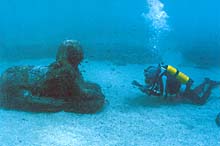 One of the numerous sphinxes discovered off the coast of Alexandria, Egypt by Jean-Yves Empereur's team of underwater
archaeologists in 1995. The subsidence of this area proves beyond a shadow of a doubt that vertical tectonic subsidence — the
rising and falling of land masses caused by subcrustal magma pressure — occurred in and around the Mediterranean Sea in
ancient times. Image from
Alexandria: The Sunken City.
One of the numerous sphinxes discovered off the coast of Alexandria, Egypt by Jean-Yves Empereur's team of underwater
archaeologists in 1995. The subsidence of this area proves beyond a shadow of a doubt that vertical tectonic subsidence — the
rising and falling of land masses caused by subcrustal magma pressure — occurred in and around the Mediterranean Sea in
ancient times. Image from
Alexandria: The Sunken City.
|
|
The city of
Alexandria, Egypt
was named after the famous Greek king,
Alexander the Great
(356-323). After his decisive
defeat of the Persians
in 333 b.c., Alexander had turned south to Egypt to consult the Oracle of
Amun.
When he arrived, he was hailed as the saviour of the Egyptians, and was crowned Pharaoh, the incarnation of the god Horus. As the
Persian satrap of Egypt had given up without a struggle, Alexander already had an administrative apparatus in place, but he
decided to find a new location to serve as the administrative capitol for his newly formed empire.
Though his architects had recommended a different site,
Plutarch
relates
in his
Life of Alexander
that one night Alexander had had a dream wherein a man with white hair and venerable appearance came to him and told him to
build his administrative capitol on the island of Pharos.
Homer,
better known for his epic works
The Odyssey
and
The Iliad,
was actually an
aide de campe
for Alexander, and was assigned the task of drawing up the architectural plans for the new administrative capitol of Egypt:
Alexandria, founded on April 7, 331 b.c.
Despite his victories, Alexander would die soon after in
Babylon
on June 11, 323 of an illness, and never rule over the empire that he had conquered so quickly — the largest empire in
the world to that time. That rule instead fell to his four major generals, each of which ruled over one quarter of his empire.
Of these generals Ptolemy, Alexander's brightest and best, took the rule over Egypt, founding the
Ptolemaic dynasty
of Egypt.
Ptolemy began his reign in 323 b.c., and expanded his empire to include Palestine, Cyprus, and Lybia, and other nearby
territories, after which came the golden age of Alexandria. Ptolemy was succeeded by Ptolemies II, III, IV, V, X, XII,
and the Ptolemaic age ended with the famous
Queen Cleopatra,
after whom the Roman Empire took control of Egypt and the Ptolemaic capitol, Alexandria.
Alexandria was also host to two major edifices of the ancient world: the Pharos Lighthouse
(op. cit.)
and the Library of Alexandria. The Pharos Lighthouse was a massive, 400-foot staged tower that was built on the island of
Pharos, part of Alexander's original capitol area. Considered one of the seven wonders of the ancient world,
the lighthouse was the second-tallest structure on Earth next to the pyramids.
Though less visually impressive than the lighthouse, the Library of Alexandria was far more important,
believed to have been the repository of all of the knowledge of the ancient world. The library contained over 500,000 volumes
of work, and was not a mere library but a university, where learned scholars from all over the world came to add to the
cumulative knowledge base. Here were written many works that are still studied today, including
Euclid's
The Elements
and
Optics.
It was also here that the philosopher
Eratosthenes
argued that Earth was round, and measured its diameter to within .5% accuracy, and where Aristarchus of Samos put
forward the hypothesis that Earth revolved around the Sun. Unfortunately, the library was burned by the Moslems and its
precious contents used to heat their baths.
In 1995, underwater archaeologist Jean-Yves Empereur led a team to the harbor of modern Alexandria, and found numerous
submerged artifacts from all periods of Alexandrian history. Subsequent explorations have also
uncovered evidence of even older civilizations submerged even farther than the Ptolemaic ruins. Not only have beautifully
rendered sphinxes and statues of gods and goddesses been recovered, the discovery of remnants of ancient ports deep
underwater indicated that the entire area was once much higher, but had sometime, in the distance past, been inundated
with one or more massive floods, that may have been accompanied by vertical tectonic subsidence — the vertical displacement
of land due to increasing or decreasing magma pressure.
Alexandria is a popular tourist destination due to its easy access to the Mediterranean Sea, and is also a natural cruise
destination. Contact
Tour Egypt
for more information on your Alexandrian vacation.



 Alexandria, Egypt
Alexandria, Egypt
 The Alexandria History Guide:
The Alexandria History Guide:
-
The Founding of Alexandria
-
Map of Ancient Alexandria
-
The Ptolemaic City
-
Cleopatra: The Last Pharaoah
-
The Ptolemaic Legacy
-
The Roman City
-
The Arab City
-
The Modern City
 Archaeology: "Diving on a Sunken City"
Archaeology: "Diving on a Sunken City"
 The Library of Alexandria
The Library of Alexandria
 The Bibliotheca Alexandrina
The Bibliotheca Alexandrina
 The Revival of the Ancient Library of Alexandria
The Revival of the Ancient Library of Alexandria
 Alexandria Digital Library Project
Alexandria Digital Library Project
 Alexandria on the Web
Alexandria on the Web
 Alexandria Visitor Guide
Alexandria Visitor Guide
 EgyptSites: Alexandria
EgyptSites: Alexandria
 Tour Egypt: Alexandria
Tour Egypt: Alexandria
|
|

|

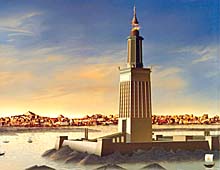
The Pharos Lighthouse, named after the island on which it was built in the harbor of Alexandria, Egypt. The Lighthouse is calculated
to have been anywhere from 300-600 feet tall, and its light, powered by fire and a "magic mirror", was reported to have been visible
over 35 miles away. Image from
Alexandria: The Sunken City.
|
|
The Pharos Lighthouse, also known as
"The Great Lighthouse at Alexandria",
was, basically, a lighthouse designed to warn incoming shipping of the dangerous, rocky harbor of Alexandria. What made this
lighthouse so spectacular, however, was its massive size, the methods used to build and maintain it, and the strange, almost supernatural
powers that have been ascribed to the fabulous "magic mirror" that lay at its heart. For these reasons and more, the Pharos Lighthouse
was considered one of the
seven wonders of the ancient world.
The lighthouse was originally commissioned by Alexander's
(op cit)
greatest general,
Ptolemy Soter,
around 297 b.c., and completed by his son, Ptolemy II Philadelphus around 282 b.c. However, though Ptolemy II did not build the
structure, or even commission it, he was more than willing to take credit for it, and ordered that his name, not the builder's,
be engraved upon its base. The wily builder, however, one
Sostranes of Knidos,
followed the king's orders, and inscribed Ptolemy II's name on a patch of highly degradable plaster. On the hard stone underneath
the plaster, however, he placed his own name in the inscription: "Sostrates, son of Dexiphanes of Knidos on behalf of all Mariners to
the Savior Gods". Centuries later, after Ptolemy II and Sostrates had both passed on, wind and weather from the sea eventually made
apparent the true builder of the lighthouse.
The lighthouse was actually constructed on Pharos island, west of the Nile delta, so as to guide ships away from the unnavigable silty
water therein. It was made of huge, marble blocks that were mortared together with lead mortar, and was constructed in three stages.
The first stage was a giant square block, 100 feet wide and 200 feet tall. Inside this first stage was a huge, spiral ramp that was
used to cart in fuel and other materials necessary for the upkeep of the lighthouse. The second stage was an eight-sided tower that
contained a spiral staircase, as well as a dumbwaiter for hauling up fuel for the fire that provided light at night. The third and
final stage was circular and thinner than the previous two. The fire and the "magic mirror" were contained in this stage, and a
statue of Poseidon presided over its summit.
Though the size and construction of the tower have been generally better documented than most ancient monuments, the mysterious
"magic mirror" at its summit remains a mystery. Some have speculated that it was simply a polished metal mirror and a particularly
large fire. Others have speculated that it was a particularly ingenious lens that greatly amplified the light of the sun and/or
the fire that burned in its midst. Or, perhaps its was something even more advanced — so advanced that we are only now beginning
to understand
the technology behind it.
Though the Pharos Lighthouse was destroyed by a series of earthquakes, and its remains have all but disappeared under the
encroaching waters
of the Mediterranean,
underwater excavations
have uncovered numerous treasures, including potential
artifacts of the Pharos itself.
These include numerous sphinxes, granite columns, capitals, obelisks, a headless statue of Ramesses II, and massive stone sculptures of
Ptolemy — represented as the god Osiris — and the
torso
of a similar statue of Ptolemy's queen, who is represented as the goddess Isis. Were these the "savior gods" referred to in the
inscription? Or perhaps a
reference to the constellation of Gemini, reliable guide to sailors worldwide? Another mystery to solve.
For more information about visiting Alexandria and uncovering the mysteries for yourself, visit
EgyptSites: Alexandria
for more information, or check out
Tour Egypt: Alexandria
to get started on planning your Egyptian vacation.



 The UnMuseum: "The Great Lighthouse at Alexandria"
The UnMuseum: "The Great Lighthouse at Alexandria"
 The University of Florida: "The Lighthouse at Alexandria"
The University of Florida: "The Lighthouse at Alexandria"
 NOVA Online: Treasures of the Sunken City
NOVA Online: Treasures of the Sunken City
 Hellenic: The Pharos of Alexandria
Hellenic: The Pharos of Alexandria
 Archaeology: Diving on a Sunken City
Archaeology: Diving on a Sunken City
 Archaeology: Pharos Sculpture Recovered
Archaeology: Pharos Sculpture Recovered
 UNESCO: Underwater Archaeological Investigations of the Ancient Pharos
UNESCO: Underwater Archaeological Investigations of the Ancient Pharos
 CNN Destinations: The Pharos (Lighthouse) of Alexandria
CNN Destinations: The Pharos (Lighthouse) of Alexandria
 Clevelys: The Great Pharos Lighthouse
Clevelys: The Great Pharos Lighthouse
 Structurae: Pharos Lighthouse
Structurae: Pharos Lighthouse
 Alexandria Visitor Guide
Alexandria Visitor Guide
 EgyptSites: Alexandria/Pharos Lighthouse
EgyptSites: Alexandria/Pharos Lighthouse
 Tour Egypt: Alexandria
Tour Egypt: Alexandria
|
|
|
|

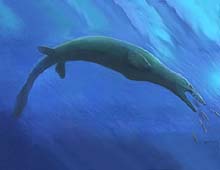
A mosasaur, a type of aquatic dinosaur believed to have become extinct at the end of the
Cretaceous Period,
some of which may have remained to become the legendary "Champ" of Lake Champlain. Underwater
recordings have recently picked up the sound of a mammal similar to that emitted by dolphins, who use echolocation to
help them navigate and find prey. The sound matches no known aquatic mammals.
Click
here
to here the recorded sound, from
AnimalVoices.com
.
|
|
In June of 2003, while doing research for a Discovery Channel special on Champ of Lake Champlain, a team of scientists recorded
an unusual sound: a mysterious clicking noise very similar to that emitted by dolphins and other types of whales that they use
to navigate deep water and locate prey. Though there are aquatic mammals living in the lake, such as seals, none of them use
echolocation,
a form of communication that, to this point, was believed to be unique to the whale family.
There are various theories about the identity of Champ. Some believe that Champ is a plesiosaur, as many have described him as
having a small, horselike head on a long neck that he occasionally raises above the water to scan the countryside. Others believe
he is another type of large saurian remnant such as a mosasaur (above) or a zuegledon, a fossil whale that was the ancestor of
modern whales. However, some describe him as undulating vertically, a form of locomotion that is typical of sea serpent and lake
monster sightings around the world, but not typical of plesiosaurs and mosasaurs, which had rigid backbones and thus could not
undulate. As a result, Champ and his ilk do not appear to be any kind of known creature.
However, Dennis Jay Hall of
Champ Quest
believes that he has found the answer: Champ is a remnant of an obscure type of dinosaur known as
Tanystropheus,
a member of the
Protorosaur
family. This ancient form of dinosaur appears to have been amphibian in nature, traveling easily both on water and on land, but with
some differences — primarily the fact that it gives birth to live young. Hall has entitled Lake Champlain's apparent
Tanystropheus remnants Champtanystopheus. However, though this would appear to solve the problem,
Tanystropheus was not a strong swimmer, its primary form of locomotion being walking, like most lizards. Many sightings of
Champ show a strong, fast swimmer, so Tanystropheus may not be answer. As such, it appears that Champ and its ilk are
actually a form of aquatic creature that has yet to be catalogued.
Lake Champlain, "the sixth Great Lake", is a large, freshwater lake sandwiched between Vermont and New York, also extending some ways into Canada's Quebec province. Ninety percent of the water that replenishes the lake is derived from the Lake Champlain basin, which was created by glacial action. Several mountain chains are present in the valley also, including the Adirondacks, the Green Mountains, and the Taconic Mountains. Lake Champlain, though it does not rank in size with the Great Lakes, is still an imposing body of water, stretching 120 miles at its longest point from Whitehall, New York north across the U.S.-Canadian border to its outlet at the Richelieu River in Quebec. Champlain is also 12 miles at its widest point, and over 400 feet deep at its deepest point � more than enough lake to harbor a monster.
Lake Champlain is a popular tourist destination, offering fishing, boating, good restaurants and lodging and, of course,
sightseeing. In spring of 2003, a Vermont aquarium and science center named
ECHO
opened in Burlington, VT. ECHO has a permanent Champ display, showing a history of the creature, and the latest research regarding
this mysterious creature, including the mysterious
sound.
Special displays and lectures are also occasionally included, particularly during the month of August, which is their official
"Champ month".
For more information on how to start on your own Champ quest, contact Dennis Jay Hall at
sighting@champquest.com. For more information on visiting Vermont and the Lake
Champlain region, check out
Travel Vermont, the official Vermont tourism site.


 Mysterious World: Champ: The Monster of Lake Champlain
Mysterious World: Champ: The Monster of Lake Champlain
 American Leisure Fisherman Filmed Three Unknown Animals
American Leisure Fisherman Filmed Three Unknown Animals
 Boston.com Travel: New Evidence on Champ is Luring Sea-Monster Fans to Vermont
Boston.com Travel: New Evidence on Champ is Luring Sea-Monster Fans to Vermont
 AnimalVoice.com: Lake Champlain Research
AnimalVoice.com: Lake Champlain Research
 AnimalVoice.com: Champsong
AnimalVoice.com: Champsong
 Universita' di Pavia Bioacoustic Research Center: Dolphin Song
Universita' di Pavia Bioacoustic Research Center: Dolphin Song
 ECHO: Leahy Center for Lake Champlain
ECHO: Leahy Center for Lake Champlain
 Travel Vermont
Travel Vermont
 Lake Champaign Valley Chamber of Commerce
Lake Champaign Valley Chamber of Commerce
 Lake Champlain Shoreline Cruises
Lake Champlain Shoreline Cruises
 Lake Champlain Ferries
Lake Champlain Ferries
|
|
Atlantis in Bolivia
|
Alexandria
|
Pharos Lighthouse
|
Champ
|
Books
|
Video
Editorial
|
Press Releases
|
Book Reviews
|
Fragments
Serpent Mound II
|
Giants II
|
Osiria II
Register
for our new Hall of Records Newsletter!
Questions? Comments? Suggestions? Advertising? Press Releases?
Contact us!



 Atlantis: The Andes Solution: The Discovery of South America As the Legendary Continent of Atlantis
Atlantis: The Andes Solution: The Discovery of South America As the Legendary Continent of Atlantis
James M. Allen, John Blashford-Snell (Foreword)
Allen, a former air photo interpreter for Britain's Royal Air Force who has also studied ancient measurements, weighs in here with
another theory concerning the legendary lost continent. Based on Plato's account (reprinted here)
and his own research, which included a trip to South America, Allen argues that the site of Atlantis was on the Bolivian Altiplano
(a series of high plains). Allen's major points rest on rather shaky foundations: the similarity of the Bolivian terrain to the
geographical details in Plato's dialogues; the fact that floods and earthquakes have occurred in the Bolivian Altiplano; and the
fact that precious metals referred to by Plato as mined in Atlantis are also found in Bolivia. This is enjoyable reading, but seems
more an exercise in textual legerdemain than science as Allen relies heavily on his own interpretation of Plato, which makes his
ideas intriguing rather than convincing. Atlantis buffs will want to add this to their shelves, but few readers will be convinced
by the many parallels Allen attempts to draw between the ancient cultures of the Mediterranean and pre-Columbian America.
Click
here
to buy this book.
 Footprint Bolivia Handbook
Footprint Bolivia Handbook
Alan Murphy, Kate Hannay, Roger Perkins
Home to the world's highest salt lake and loftiest capital city, extreme highs are what you can expect to find in this fully updated third edition of the Bolivia Handbook. This is real Butch Cassidy and Sundance Kid territory, with hair-raising adventures to be found for every traveler who fancies retracing the steps of the infamous Wild West outlaws. From the action-packed adventure section covering mountaineering, trekking, skiing, mountain biking, and expanded information on hiking routes, to the comprehensive and fascinating coverage of the country's numerous national parks including the Parque Nacional Amboro, this guide will fulfill whatever the outdoor adventurer craves. Insights into the diverse Bolivian contemporary culture and the fundamentals on fiestas (what do they mean? where are the best ones?) will bring the culture-seeker that much closer to the native's Bolivia. Rounded out with full coverage of the latest eco-tourism developments and a complete spectrum of accommodation options to suit all budgets and tastes, as well as over 39 color and black and white maps cross-referenced with the text,
(Review by Amazon.com)
Click
here
to buy this book.
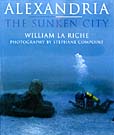 Alexandria: The Sunken City
Alexandria: The Sunken City
William La Riche, Stephane Compoint (Photographer)
Alexandria: The Sunken City is an top-quality photographic essay of Jean-Yves Empereur's 1995 underwater expedition off the coast of Alexandria, Egypt. There, Empereur and crew found a gold mine of archaeological artifacts, including massive stone sculptures, pillars covered with Egyptian hieroglyphics, and even numerous sphinxes. This now-submerged part of ancient Egyptian history is considered to be one of the greatest archaeological finds of the twentieth century, and Alexandria: The Sunken City covers the subject well in a simply written, lavishly illustrated coffee-table-sized book that is a must have for anyone interested in underwater archaeology, Egyptology, the ancient history of the Mediterranean, and related disciplines.
(Review by Mysterious World)
Click
here
to buy this book.
 Lonely Planet Egypt
Lonely Planet Egypt
Humphreys Andrew, Siona Jenkins, Andrew Humphreys
Whether you want to cruise down the Nile, explore ancient sites or soak up the sun in Sinai, this guide is the perfect companion
for exploring Egypt - a land that has tempted travellers for centuries.
 104 detailed maps, including a full-colour country map 104 detailed maps, including a full-colour country map
 Special section on Pharaonic Egypt, including a who's who of gods & goddesses and
a user's guide to reading hieroglyphs Special section on Pharaonic Egypt, including a who's who of gods & goddesses and
a user's guide to reading hieroglyphs
 The lowdown on camel trekking in Sinai, desert safaris and felucca trips The lowdown on camel trekking in Sinai, desert safaris and felucca trips
 Up-to-date advice on where to stay and eat on any budget Up-to-date advice on where to stay and eat on any budget
 Hot tips on where to dive and snorkel in the Red Sea Hot tips on where to dive and snorkel in the Red Sea
(Review by Amazon.com)
Click
here
to buy this book.
 Champ Quest 2000: The Ultimate Search Field Guide & Almanac for Lake Champlain
Champ Quest 2000: The Ultimate Search Field Guide & Almanac for Lake Champlain
Dennis Jay Hall
Lake Champlain is home to a breeding colony of Loch Ness type animals. Within you will find the best search dates for the Summer of 2000. This field guide is a must for anyone with an interest in Cryptozoology, it goes way beyond any book in print when it comes to hard evidence and facts. Thirty years spent searching for and finding these ancient reptiles has made Dennis Hall the world's #1 authority on the animals that have chosen Lake Champlain as their home. This book is for kids and adults of all ages. With close to fifty photographs, maps, and illustrations this book is hard to close once opened. It includes a monthly calendar of best search dates for finding the elusive creatures we fondly call "Champ" (May through November 2000), recent sightings, historical sightings, new evidence, and chapters on zebra mussels & blue-green algae. Dennis has included many photos, stills from his 1985 video of Champ, maps, & sonar evidence. It's really great reading with lots of graphics.
(Review by Amazon.com)
Click
here
to buy this book.
Editorial
|
Press Releases
|
Book Reviews
|
Fragments
Serpent Mound II
|
Giants II
|
Osiria II
Register
for our new Hall of Records Newsletter!
Questions? Comments? Suggestions? Advertising? Press Releases?
Contact us!
|

